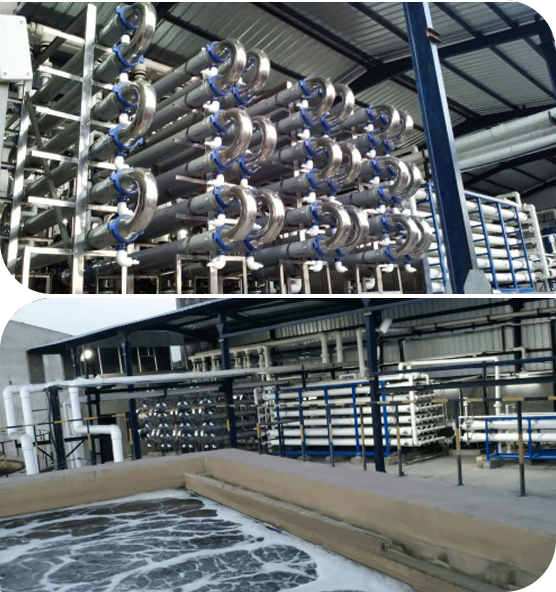
Waterman Engineers Australia has become the leading companies of Zero Liquid Discharge process. A ZLD process is a treatment procedure which can be employed to get rid of each of the liquid waste from the process. The target of ZLD drinking water remedy is to cut back wastewater economically and create potable h2o that may be in good shape for usual use. Zero discharge technique is an advanced treatment process that comprises ultrafiltration, reverse osmosis, evaporation and fractional electro deionization. And we have been a effectively-known provider of ZLD techniques.
In several Industries, for example electrical power, oil & fuel, chemical compounds, mining and Other people, a great deal of wastewater is generated that needs to be managed. Conventionally, this discharge of wastewater is done by means of a plant outfall to some area water overall body like an evaporation pond, or in some instances deep perfectly injected. These methods produce several environmental fears by the public in lots of locations of the planet, as drinking water is usually a scarce source and its management really should be monitored. These issues have resulted while in the institution of ZLD procedures by numerous industries to minimize their environmental footprint and enrich sustainability. And, Waterman Engineers Australia are best ZLD suppliers you could find for This method.
Attributes OF ZERO LIQUID DISCHARGE SYSTEM
The Qualities of a Zero Liquid Discharge technique can differ based on the certain style and design and technological know-how used. Nevertheless, some frequent Homes of ZLD programs incorporate:
Drinking water Conservation: One among the principal goals of ZLD techniques is always to conserve h2o by reducing the discharge of liquid waste in to the atmosphere.
Higher H2o Purity: ZLD units are built to make substantial-top quality water that may be absolutely free from impurities and contaminants, which makes them suitable for use in several industrial processes.
Flexibility: ZLD programs tend to be designed to support a broad choice of input liquid streams, that makes them flexible and well suited for use in numerous industries.
Advanced Wastewater Cure: Zero liquid discharge techniques use advanced wastewater cure methods to clear away impurities and contaminants in the effluent, manufacturing higher-excellent water.
Waste Reduction: ZLD devices assist lower squander by decreasing the amount of liquid squander that should be disposed of and by creating a concentrated, reliable squander material that may be safely and securely disposed of.
Electrical power Efficiency: ZLD techniques is often Electrical power-intensive as a result of substantial Electrical power requirements of evaporation along with other wastewater treatment method processes. On the other hand, innovations in technology are creating Zero liquid discharge methods a lot more Vitality-productive and value-successful.
Waterman Engineers Australia manufactures Zero Liquid Discharge (ZLD) techniques created to get rid of all liquid waste, aiming to produce potable h2o and lower environmental impression. Their ZLD devices generally incorporate ultrafiltration, reverse osmosis, evaporation, and fractional electro deionization. Crucial technologies made use of are Slipping Film Brine Concentrators, Compelled Circulation Crystallizer, and Some others, by using a two-stage process of pre-focus and evaporation/crystallization to recover and reuse h2o. These programs are adaptable to distinct industries, emphasizing h2o conservation, substantial water purity, squander reduction, and Power performance. Specialized technical specs are assorted and customizable, thinking about factors like drinking water resource, circulation rate, and feed drinking water quality.
The need for Zero Liquid Discharge (ZLD) units arises with the necessity to handle environmental fears connected with h2o scarcity and pollution. In industries like electricity, oil & fuel, and mining, huge quantities of wastewater are created. Historically, this wastewater is discharged into bodies of drinking water, producing pollution and depleting thoroughly clean drinking water means. ZLD methods goal to reduce these impacts by managing and recycling wastewater within the industrial approach, therefore conserving h2o, reducing waste, and marketing sustainability.
When it comes to the complex technical specs of the Zero Liquid Discharge (ZLD) procedure, important elements to give attention to incorporate the drinking water supply it can take care of, the process's move level, the standard of feed h2o, the phases of treatment method concerned, the recovery price of water, methods for focus disposal, elements of development, working situations, and program automation and Manage. These factors make sure the technique's efficiency, sturdiness, and performance in dealing with and recycling industrial wastewater.
Zero Liquid Discharge (ZLD) plants offer Gains for instance water conservation, squander reduction, and pollution avoidance, contributing to environmental sustainability. They're relevant in industries like electricity generation, oil and Zld System Manufacturer Zero Liquid Discharge System fuel, chemical substances, and mining, exactly where they assist in handling industrial wastewater effectively, cutting down the ecological footprint, and complying with stringent environmental polices. These programs are essential in parts dealing with h2o scarcity and for industries aiming to improve their sustainability and operational effectiveness.
FAQs for a Zero Liquid Discharge (ZLD) technique often tackle its operational concepts, Expense-success, maintenance necessities, environmental impact, applicability across several industries, and regulatory compliance. These questions support buyers comprehend the technique's benefits, technical needs, and suitability for their precise wastewater administration needs.
1. Zero Liquid Discharge (ZLD) is actually a wastewater treatment method system designed to eradicate all liquid waste.
2. The program's components are affected by the precise industrial system, wastewater composition, and regulatory requirements.
three. Effluent treatment crops remove pollutants from textile effluents to prevent environmental contamination.
four. Advantages include h2o conservation, air pollution reduction, and regulatory compliance.
five. The purpose is to reduce environmental effect by recycling water and reducing squander.
six-9. Effluent treatment crops are phases in wastewater treatment method: Major (physical separation), secondary (Organic cure), and tertiary (State-of-the-art treatment method).
10. Device operations consist of filtration, sedimentation, Organic treatment method, and disinfection.
11. Restricting parameters are aspects that have an effect on the treatment's performance, like pH and contaminant concentration.
twelve. Design and style concerns involve stream charge, effluent composition, and desired excellent of handled h2o.